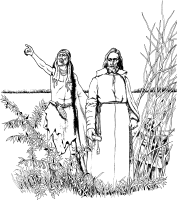|
The Jesuits are known mostly for their missions, promoted to a large degree by Francis Xavier, one of the first Jesuits. Determined to convert as much of the world as possible, Xavier sailed to Goa, off the Indian coast in 1542. Although ill, he baptized thousands before traveling on to Sri Lanka,  Malaysia, and Japan, dying while waiting to enter China. Malaysia, and Japan, dying while waiting to enter China.
Francis Xavier has been criticized, particularly by modern church historians, for adapting the faith, for using the Inquisition, and for approving of persecution; but his example persuaded thousands to follow.
Dominicans and others traveled with merchants and explorers to India, the Americas, and to Asia, baptizing the masses into an often poorly understood faith. Jesuit strategy was to win the ruler's allegiance to Christ, so that he in turn would mandate the conversion of his subjects.
Despite two centuries of effort, the Jesuits met little success in China. In Japan, many were converted by the end of the 16th century, but subsequent persecution eradicated Christianity from Japan in the following decades.
South America
It is said that Christopher Columbus discovered America in 1492. As Portugal and Spain competed for parts of the New World, Pope Alexander VI drew a line down the Atlantic, declaring that all land to the west of it belonged to Spain, all land to the east to Portugal.
Cortes came to Mexico and found an advanced civilization known to us as the Aztecs. Following the armies came the priests, baptizing the aborigines, but making little effort to instruct them in the Christian faith. Often they were treated as slaves by their Spanish masters.
An obvious result of this rapid but superficial conversion was that many pagan customs and beliefs were swept up into Mexican Christianity, as two religions merged to create a single, muddied system of beliefs. This mingling of contradicting beliefs continues to this day in many Latin American countries.
|
